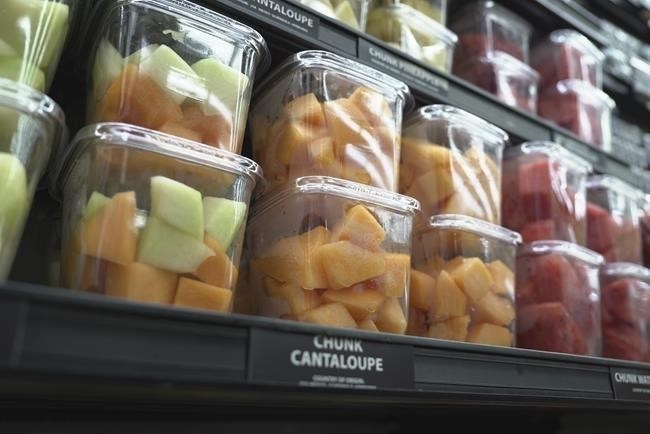
Cantaloupe pieces are displayed for sale at a supermarket in New York on Tuesday, Dec. 12, 2023. In 2023, hundreds of people in the U.S. and Canada have been sickened in a growing outbreak of salmonella poisoning linked to contaminated whole and pre-cut cantaloupe.
Image Credit: (AP Photo/Mary Conlon)
December 18, 2023 - 11:34 AM
Hundreds of people in the U.S. and Canada have been sickened and at least 10 people have died in a growing outbreak of salmonella poisoning linked to contaminated whole and pre-cut cantaloupe.
Health officials are warning consumers, retailers and restaurants not to buy, eat or serve cantaloupe if they don’t know the source.
That’s especially important for individuals who are vulnerable to serious illness from salmonella infection and those who care for them. High-risk groups include young children, people older than 65 and those with weakened immune systems.
The U.S. Centers for Disease Control and Prevention is especially concerned because many of the illnesses have been severe and because victims include people who ate cantaloupe served in childcare centers and long-term care facilities.
Here’s what we know about this outbreak:
How many people have been sickened in the cantaloupe salmonella outbreak?
Overall, at least 302 people in the U.S. and 153 in Canada have been sickened in this outbreak. That includes four killed and 129 hospitalized in the U.S. and six killed and 53 hospitalized in Canada.
When did the cantaloupe outbreak begin?
The first U.S. case was a person who fell ill on Oct. 16, according to the CDC. The latest illness detected occurred on Nov. 28. Canadian health officials said people fell ill between mid-October and mid-November.
The first recalls were issued Nov. 6 in the U.S., according to the Food and Drug Administration. Multiple recalls of whole and cut fruit have followed.
Where did the cantaloupes come from?
The cantaloupes implicated in this outbreak include two brands, Malichita and Rudy, that are grown in the Sonora area of Mexico. The fruit was imported by Sofia Produce LLC, of Nogales, Arizona, which does business as TruFresh, and Pacific Trellis Fruit LLC, of Los Angeles. So far, more than 36,000 boxes or cases of cantaloupe have been recalled.
On Dec. 15, Mexican health officials temporarily closed a melon-packing plant implicated in the outbreak.
Roughly one-third of FDA-regulated human food imported into the U.S. comes from Mexico, including about 60% of fresh produce imports. The average American eats about 6 pounds of cantaloupe a year, according to the U.S. Department of Agriculture.
How did the cantaloupes get contaminated?
Health officials in the U.S. and Canada are still investigating, but cantaloupes generally are prone to contamination because they are “netted” melons with rough, bumpy rinds that make bacteria difficult to remove.
Salmonella bacteria are found in animals' intestines and can spread if their waste comes in contact with fruit in the field. Contamination can come from tainted water used in irrigation, or in cleaning and cooling the melons.
Poor hygienic practices of workers, pests in packing facilities and equipment that’s not cleaned and sanitized properly can also lead to contamination, the FDA says.
The Mexico growing area saw powerful storms and hurricanes in late summer and early fall that resulted in flooding that could be a factor, said Trevor Suslow, a produce safety consultant and retired professor at the University of California, Davis.
Once the melons are contaminated, the nubby rinds harbor nutrients that can help the salmonella bacteria grow, Suslow said.
If the cantaloupe become moldy or damaged, the bacteria can move from the outside of the rind to the inner layer or into the flesh. Also, when the fruit is sliced — in a home kitchen, grocery store or processing plant — the bacteria can spread to the flesh.
Cut fruit in a tray or clamshell package can harbor the bacteria. If the fruit isn’t kept very cool, the germs can grow.
How should consumers handle cantaloupe?
It is difficult to remove disease-causing bacteria from cantaloupe at home. Food safety experts recommend rinsing whole melons in cool water and scrubbing them with a clean produce brush and then drying completely.
Blanching the cantaloupes briefly in very hot water is another method, Suslow said. And Purdue University researchers found that household items such as vinegar and iodine diluted in water could reduce exterior contamination with salmonella by 99%.
For high-risk people, it might be best to avoid cantaloupe, especially pre-cut cantaloupe and especially during an outbreak, said Amanda Deering, a Purdue University food scientist.
Understanding that certain foods can pose a serious health risk is key, she added.
“As consumers, we just assume that our food is safe,” she said. “You don’t want to think that a cantaloupe is what’s going to take you out.”
— The Associated Press Health and Science Department receives support from the Howard Hughes Medical Institute’s Science and Educational Media Group. The AP is solely responsible for all content.
News from © The Associated Press, 2023